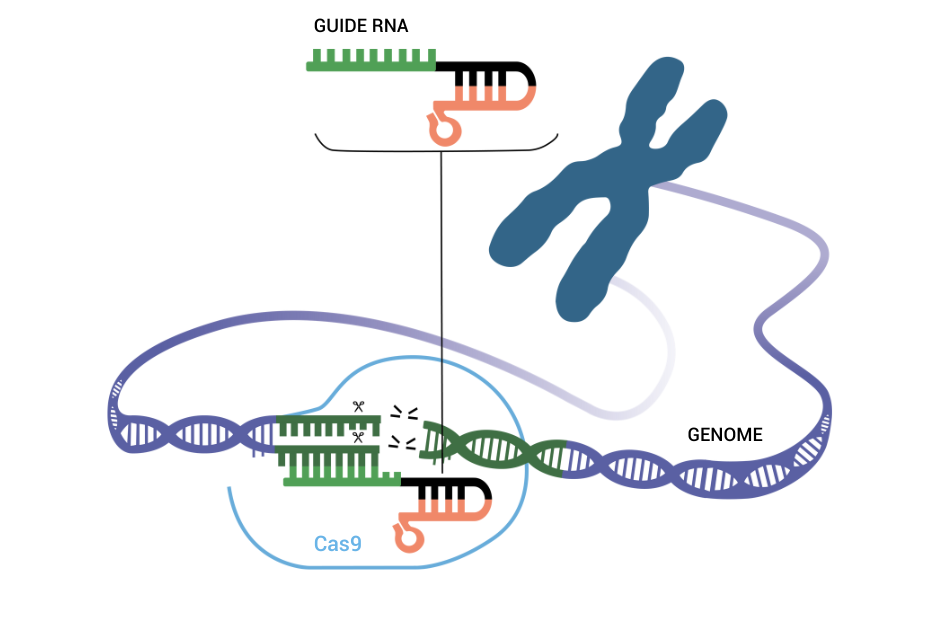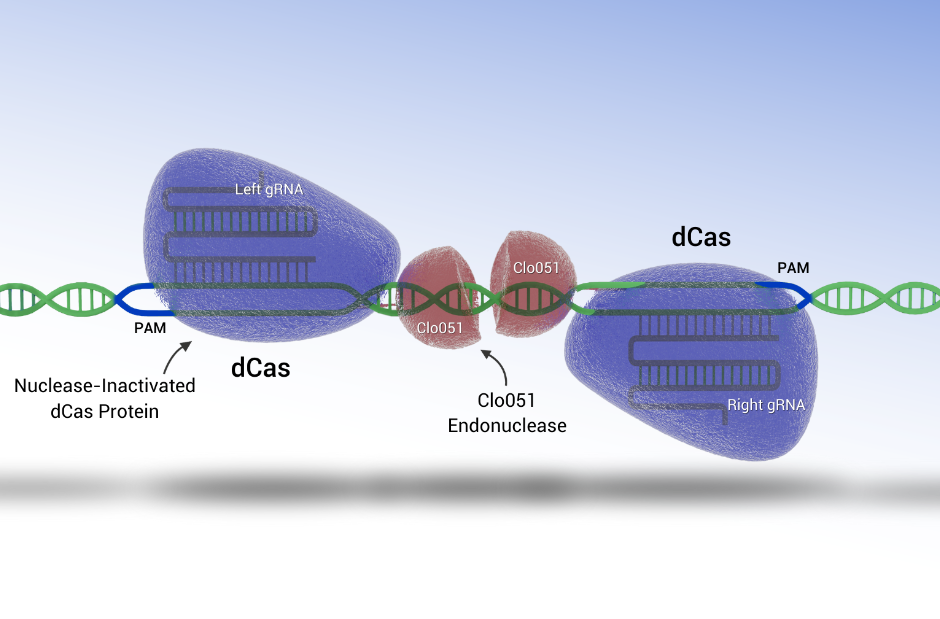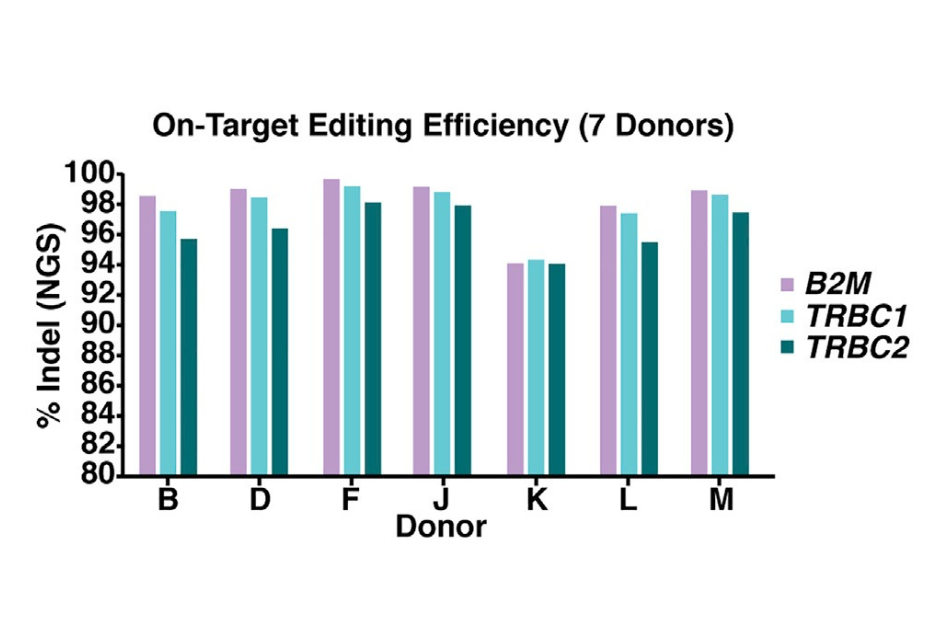Demeetra’s Guide to CRISPR and Gene Editing Licensing

Figure 1: A general schematic of CRISPR’s simple single gRNA mechanism and function. Includes two outcomes: error-prone repair, which generally results in a LOF mutation, and template-based repair where genetic functionality is altered and genome is changed.
While today many scientific articles present a simple process of editing one or more genes, gene editing with other technologies presented major technical challenges before CRISPR-based guide RNA (gRNA) technology. CRISPR has made advancements in research far more accessible due to the use of a simple gRNA system for gene targeting as opposed to the intense protein engineering required with older technologies (i.e. TALENs and ZFNs).
However, CRISPR/Cas9 implementation has proven more difficult for commercial product development due to lack of clear intellectual property (IP) freedom to operate (FTO) and licensing cost and complexity. A December 2023 license between Vertex Pharmaceuticals and Editas Medicine as reported in Fierce Biotech underscores Cas9 licensing burdens. Vertex already had a longstanding partnership with CRISPR Therapeutics for "foundational" CRISPR/Cas9 IP. Yet, when the time came to commercialize, Vertex paid a $100M upfront fee plus potential yearly fees in the tens of millions and royalties to Editas Medicine, a separate holder of foundational CRISPR/Cas9 IP. The license was to a single gene for limited applications and was non-exclusive.
The Demand For CRISPR Technology Surges, But Licensing Frustrations Prevent Forward Movement
In preparation for the development of CRISPR-edited products such as crops, yeasts and cell lines, many companies began the process of confirming access to commercial freedom-to-operate (FTO), but experienced challenges from the outset.
Many questions remain about the true patent holders for “foundational” CRISPR/Cas9, its various applications, how to access the IP, and even in which countries different patent holders hold rights. The Broad Institute of MIT and Harvard (“the Broad”); and the University of California (UC), the University of Vienna, and CRISPR pioneer and Nobel co-laureate Emmanuelle Charpentier, PhD (collectively known as “CVC”) – are the two primary groups who claim rights to core CRISPR/Cas9 IP.1
It is not an easy process for independent companies and other potential users to navigate commercial use. In early 2022, the United States Patent, Trial and Appeal Board (PTAB) issued a judgment in favor of the Broad. However, due to other patent complications, CVC maintains rights for compositions and uses of CRISPR/Cas9 – and may have the upper hand in Europe and elsewhere. CVC also may appeal the PTAB decision. To further complicate matters both the Broad and CVC have out-licensed their IP to companies for sub-licensing in different fields of use.
The bottom line: for commercial use of foundational CRISPR/Cas9, multiple licenses with potentially burdensome terms may need to be identified, negotiated and maintained. At Demeetra, we cut down the red tape around gene - editing research, allowing simple licensing options for all our technologies. Read more on our licensing page.
“Fights over who invented the gene–editing technology (CRISPR/Cas9) are becoming more complex, and could carry on for years.”
—Heidi Ledford, Nature Magazine 2022
Cas-CLOVER, A Proven CRISPR/Cas9 Alternative to Foundational CRISPR/Cas9
As efforts to obtain proprietary licensure increased, the tensions between all stakeholders became more apparent. While patent attorneys argued, scientists began introducing more enhanced versions of the original CRISPR based technology.
Cas-CLOVER, a dimeric targeted nuclease system, was first invented at Demeetra’s parent company Transposagen Biopharmaceuticals in 2015. The patents and applications are now held by Poseida Therapeutics, a spin-out of Transposagen. Clo051, the dimeric nuclease that cuts the genome was invented in 2011 at the Helmholtz-Zentrum München. Both sets of IP are licensed exclusively to Demeetra for agriculture and cell and microbial bioprocessing. The beauty of the system lies in its ability to target the gene(s) of interest through multiple mechanisms, such as different compositions of gRNAs and evolved inactivated Cas proteins. Clo051 is fused to the target binder in a dual approach (see figure 2 below) to complete genomic cleavage. Cas-CLOVER differentiates from the foundational CRISPR/Cas9 system in many aspects – including Clo051’s cleavage, which results in very different insertions and deletions (INDELs) than Cas9 and higher specificity.

Figure 2: Cas-CLOVER: Dual gRNAs complex with nuclease inactivated Cas proteins (dCas) fused to dimeric Clo051 to mediate cleavage within the spacer between each monomer.
Advantages of Using Cas-CLOVER
As efforts to obtain proprietary licensure increased, the tensions between all stakeholders became more apparent. While patent attorneys argued, scientists began introducing more enhanced versions of the original CRISPR based technology.

Figure 3: Measurement of indels in targeted loci by NGS following purification of TCR-negative CAR-T cells2
Cas-CLOVER Features:
- Ease of use: gRNA plug and play infrastructure – flexible spacer region
- High efficiency
- High fidelity: cuts only when Clo051 nuclease dimerizes
- Larger deletions with overhanging staggered cuts
Cas-CLOVER offers commercial use in a single simple license, maintains the ease of design and implementation and offers the ability to avoid unwanted off-target mutations commonly generated in using CRISPR-Cas9. The frustrations of being unable to readily license CRISPR fueled a decade of new discoveries. Cas-CLOVER has already been validated in dozens of cell lines, including commercially important suspension CHO and HEK293 cells for bioproduction of biologics. Cas-CLOVER also yields efficient knockouts in primary human T cells 2 (see Figure 3 above). Further, tobacco and other crops, as well as yeast, have been successfully edited with Cas-CLOVER.
Partnering With Demeetra
The constraints placed by organizations that govern CRISPR/Cas9 licensing have forced many researchers to look to other solutions entirely. Our Cas-CLOVER technology, which edits genes more precisely than CRISPR, is covered by patents that are distinct from those of CRISPR, so our commercial users can wield greater freedom.
We look forward to creating more opportunities with our streamlined and easy to evaluate and license biotechnology.
Reference
- The Latest Round in the CRISPR Patent Battle Has an Apparent Victor … https://www.sciencemag.org/news/2020/09/latest-round-crispr-patent-battle-has-apparent-victor-fight-continues/.
- Madison BB, Patil D, Richter M, Li X, Tong M, Cranert S, Wang X, Martin R, Xi H, Tan Y, Weiss L, Marquez K, Coronella J, Shedlock DJ, Ostertag EM. Cas-CLOVER is a novel high-fidelity nuclease for safe and robust generation of TSCM-enriched allogeneic CAR-T cells. Mol Ther Nucleic Acids. 2022 Jun 29;29:979-995. doi: 10.1016/j.omtn.2022.06.003. PMID: 36189080; PMCID: PMC9481872.
